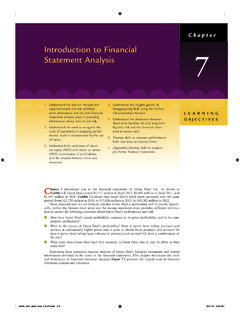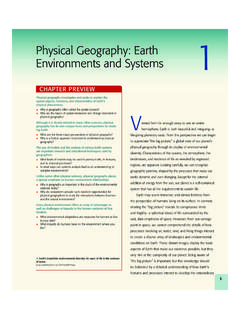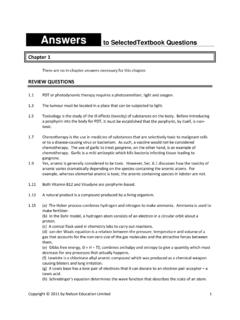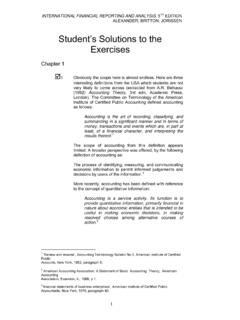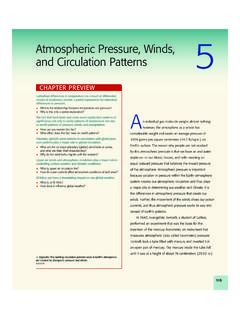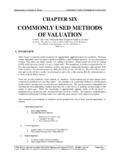Transcription of CHAPTER 1 Introduction to Taxation - Cengage
1 1-1 2010 Cengage Learning. All Rights Reserved. May not be scanned, copied or duplicated, or posted to a publicly accessible website, in whole or in part. CHAPTER 1 Introduction to Taxation CHAPTER HIGHLIGHTS proper analysis of the United States tax system begins with an examination of the tax structure and types of taxes employed in the United States. Knowledge of historical principles that guided the development of the system, and investigating the various motivations that underlie existing provisions of the tax law, will help in understanding the US tax system. This CHAPTER also introduces the various taxable and nontaxable business entities and provides an overview of tax planning. I. The Structure of Taxes (Tax Terminology) A. Taxes have two components: tax rate and tax base. B. Tax Rates Tax rates can be structured to yield: 1. Proportional tax: The rate of tax remains constant over the tax base (sales tax); 2. Progressive tax: Tax rates increase as the tax base grows larger (Federal income, gift & estate tax); 3.
2 Regressive tax: Tax rates decrease as the tax base grows larger (Federal employment taxes such as FUTA and FICA). C. Tax Base Most taxes are levied on one of the following tax bases: 1. Transactions (including sales and transfers of wealth); 2. Property or wealth (including real estate taxes and ownership of property); 3. Privileges and rights (including the ability to use the corporate form or to be in certain professions, excise taxes, and custom duties); 4. Income (can be on gross or net income). II. Types of Taxes A. After income taxes, transaction taxes usually affect more US taxpayers than any other type of tax. In many countries, transaction taxes are even more important than income taxes. B. Taxes on the Production and Sale of Goods: Levied on the sale, consumption, or production of commodities or services. Examples of transaction taxes include: 1. Excise Taxes a. Levied by Federal and state governments on exchanges of specified commodities (oil, alcohol, phone service, and tobacco) or services.
3 B. Excise taxes may be levied on producers, resellers or consumers. c. May have significant impact on specific industries. d. Although excise tax rates are generally proportional, they may vary greatly from state to Sales and Use Taxes a. Major sources of income for most state and local governments, and cover a broad base of transactions. b. Items subject to tax vary by state, and rates may vary by locality. c. The rate is proportional and collected by retailers. A 1-2 2010 Edition Taxation of Business Entities 2010 Cengage Learning. All Rights Reserved. May not be scanned, copied or duplicated, or posted to a publicly accessible website, in whole or in part. d. For various reasons, states may suspend the general sales tax, either permanently on some items, or for short intervals. e. A use tax is imposed on items bought in a lower sales tax locality and transported for use in another locality. Every state that imposes a sales tax also imposes a use tax. The rate is usually the same as the sales tax rate.
4 Use taxes are difficult to enforce on many purchases. 3. Value Added Tax (VAT) a. In many countries around the world, the VAT has gained acceptance as a major source of revenue. b. A VAT is a sales tax levied on the value added at each stage of production. C. Employment Taxes: As imposed by Federal and state governments, these taxes include: 1. FICA taxes (Federal Insurance Contributions Act) a. Tax imposed on self-employed individuals, employers, and their employees. Accounts for about 1/3 of the Federal revenues; only the income tax provides more Federal revenue. b. Proceeds finance retirement (Social Security) and medical costs (Medicare) (1) Employee rate is for Social Security (SS) up to $106,800 for 2009 and for Medicare (no ceiling). Total of if income is $106,800 or less. Employer matches the contributions. (2) Self-employed pay the employee and the employer portions. This is (2 ) for SS and (2 ) for Medicare. Income limits are the same as for employees. Thus, a total of if income is $106,800 or less.
5 2. FUTA (Federal Unemployment Tax Act) a. Generally has a state counterpart. Amounts finance state unemployment compensation benefits. As with FICA, this is a regressive tax. b. For 2009 the rate is generally of the first $7,000 of wages and paid only by the employer. States may impose special taxes on employees to provide disability benefits and/or supplemental unemployment benefits. c. Federal credit of up to may be allowed for unemployment taxes paid to the state. Thus, the amount required to be paid to the IRS could be as low as D. Death Taxes: Levied by Federal and state governments on the right to transfer property at death. This is intended to prevent large concentrations of wealth. 1. Estate Taxes are imposed on the decedent. Inheritance taxes are imposed on the recipient. Estate taxes are imposed at the federal level. States may levy either or both types. 2. The tax base is the fair market value (FMV) of property owned by the decedent at death, less allowable deductions (funeral costs, administration expenses, certain taxes, liabilities of decedent, charitable contributions, and martial deduction), plus prior taxable gifts.
6 Types of Taxes Sales and Excise Taxes Employment Taxes Death Taxes Gift Taxes Property Taxes Privilege and Right Taxes Income Taxes CHAPTER 1 Introduction to Taxation 1-3 2010 Cengage Learning. All Rights Reserved. May not be scanned, copied or duplicated, or posted to a publicly accessible website, in whole or in part. KEY TERMS Progressive, Regressive, Proportional Tax Rates Flow-Through Entities Tax Avoidance, Tax Evasion Marginal, Average, Effective Tax Rates Explicit, Implicit Taxes Wherewithal to pay 3. Federal Estate Taxes use a progressive rate scheme. Rates range from 18% to 45% in 2009. However, transfers may avoid some or all Taxation through the application of the unified transfer tax credit. For 2009, this credit exempts a tax base of $ million. The amount of the credit for 2009 is $1,455,800. 4. State inheritance taxes are based on the heir s relationship to the decedent. E. Gift Taxes: Imposed on the right to transfer property during the owner s lifetime.
7 A few states impose gift taxes. 1. The base for the tax is the FMV, at the date of gift, of the property transferred. 2. Uses the same tax rates as estate taxes; that is, the estate and gift taxes are unified. The Unified Transfer Tax Credit for gifts is frozen at $345,800 (offsetting $1 million of gifts). 3. Gifts of $13,000 or less (in 2009) per donee per year are not taxable due to the annual exclusion available. Married couples may elect gift splitting, which increases the exclusion to $26,000. F. Property Taxes: Usually based on ownership or levied on wealth or capital. Those based on value are known as ad valorem taxes (at value taxes). These taxes are generally imposed by state and local governments. 1. Taxes on realty are important sources of revenue for localities. The taxes are generally not imposed on Federal and State government property or property owned by charities. Other exemptions or special rates may exist for certain types of property and certain groups of individuals.
8 2. Taxes on personalty - taxes may be imposed on property not classified as reality. Taxes on property devoted to personal use have inconsistent taxpayer compliance. Personalty used in business, however, has better compliance. Automobile property tax base may be the weight of the automobile rather than value. G. Taxes on Privileges and Rights: Usually are excise taxes. Examples of these taxes are: 1. Custom Duties - taxes on the right to move goods across national boarders. Tend to be the instrumentality for applying the protectionist policy of the US. 2. Franchise and Occupational Taxes taxes on the privilege of doing business or practicing a profession in a state or local jurisdiction. 3. Severance Taxes - imposed by some states on the extraction of natural resources. They are an important source of income in some states. H. Income Taxes: 1. Levied by the Federal, most state, and some local governments. 2. Income taxes are generally imposed on corporations, estates, trusts, and individuals.
9 Most taxing jurisdictions use a pay-as-you-go system for collecting taxes. 3. Tax Structure The basic tax formula for all taxable entities is fairly similar. a. Income is broadly included in the tax base, whereas deductions must be specifically provided for in the law. b. Tax rates are progressive; from 10% to 35% for individuals and from 15% to 35% for corporations. c. The Taxation of individuals employs an intermediate sum called adjusted gross income (AGI) to distinguish between the two types of individual deductions: for AGI, and from AGI. 1-4 2010 Edition Taxation of Business Entities 2010 Cengage Learning. All Rights Reserved. May not be scanned, copied or duplicated, or posted to a publicly accessible website, in whole or in part. 4. State and Local income Taxes Most states and a few cities impose income taxes. The calculation of these taxes usually relies, to some degree, on Federal income tax law and computations. III. Income Taxation of Business Entities A.
10 Proprietorships 1. This simple form of business is not a separate entity from the individual owner. 2. Profits are reported on the taxpayer s personal return. B. Corporations 1. Corporations are separate legal entities. Most corporations are separate taxable entities, called C corporations or regular corporations. Corporations that meet certain requirements can elect not to be treated as separate taxable entities. These corporate entities are called Sub S corporations or S corporations. 2. Both of these types of corporations, however, must file tax returns. C. Partnerships 1. While required to file a return, a partnership is not a separate taxable entity and is not subject to Taxation . 2. The financial results of the partnership flow-through to the partners and are reported on their tax returns. D. S Corporations 1. S Corporations have the legal characteristics of C corporations but are flow-through entities like partnerships. Financial results of S corporations are reported on the shareholders tax returns.
